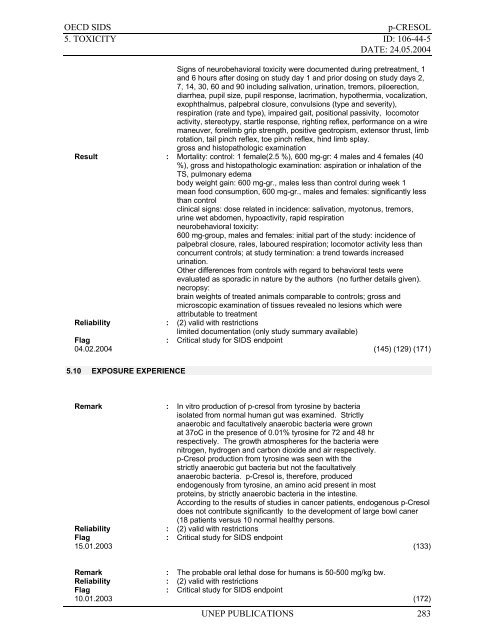m-Cresol - ipcs inchem
m-Cresol - ipcs inchem
m-Cresol - ipcs inchem
Create successful ePaper yourself
Turn your PDF publications into a flip-book with our unique Google optimized e-Paper software.
OECD SIDS<br />
p-CRESOL<br />
5. TOXICITY ID: 106-44-5<br />
DATE: 24.05.2004<br />
Signs of neurobehavioral toxicity were documented during pretreatment, 1<br />
and 6 hours after dosing on study day 1 and prior dosing on study days 2,<br />
7, 14, 30, 60 and 90 including salivation, urination, tremors, piloerection,<br />
diarrhea, pupil size, pupil response, lacrimation, hypothermia, vocalization,<br />
exophthalmus, palpebral closure, convulsions (type and severity),<br />
respiration (rate and type), impaired gait, positional passivity, locomotor<br />
activity, stereotypy, startle response, righting reflex, performance on a wire<br />
maneuver, forelimb grip strength, positive geotropism, extensor thrust, limb<br />
rotation, tail pinch reflex, toe pinch reflex, hind limb splay.<br />
gross and histopathologic examination<br />
Result : Mortality: control: 1 female(2.5 %), 600 mg-gr: 4 males and 4 females (40<br />
%), gross and histopathologic examination: aspiration or inhalation of the<br />
TS, pulmonary edema<br />
body weight gain: 600 mg-gr., males less than control during week 1<br />
mean food consumption, 600 mg-gr., males and females: significantly less<br />
than control<br />
clinical signs: dose related in incidence: salivation, myotonus, tremors,<br />
urine wet abdomen, hypoactivity, rapid respiration<br />
neurobehavioral toxicity:<br />
600 mg-group, males and females: initial part of the study: incidence of<br />
palpebral closure, rales, laboured respiration; locomotor activity less than<br />
concurrent controls; at study termination: a trend towards increased<br />
urination.<br />
Other differences from controls with regard to behavioral tests were<br />
evaluated as sporadic in nature by the authors (no further details given).<br />
necropsy:<br />
brain weights of treated animals comparable to controls; gross and<br />
microscopic examination of tissues revealed no lesions which were<br />
attributable to treatment<br />
Reliability : (2) valid with restrictions<br />
limited documentation (only study summary available)<br />
Flag : Critical study for SIDS endpoint<br />
04.02.2004 (145) (129) (171)<br />
5.10 EXPOSURE EXPERIENCE<br />
Remark : In vitro production of p-cresol from tyrosine by bacteria<br />
isolated from normal human gut was examined. Strictly<br />
anaerobic and facultatively anaerobic bacteria were grown<br />
at 37oC in the presence of 0.01% tyrosine for 72 and 48 hr<br />
respectively. The growth atmospheres for the bacteria were<br />
nitrogen, hydrogen and carbon dioxide and air respectively.<br />
p-<strong>Cresol</strong> production from tyrosine was seen with the<br />
strictly anaerobic gut bacteria but not the facultatively<br />
anaerobic bacteria. p-<strong>Cresol</strong> is, therefore, produced<br />
endogenously from tyrosine, an amino acid present in most<br />
proteins, by strictly anaerobic bacteria in the intestine.<br />
According to the results of studies in cancer patients, endogenous p-<strong>Cresol</strong><br />
does not contribute significantly to the development of large bowl caner<br />
(18 patients versus 10 normal healthy persons.<br />
Reliability : (2) valid with restrictions<br />
Flag : Critical study for SIDS endpoint<br />
15.01.2003 (133)<br />
Remark : The probable oral lethal dose for humans is 50-500 mg/kg bw.<br />
Reliability : (2) valid with restrictions<br />
Flag : Critical study for SIDS endpoint<br />
10.01.2003 (172)<br />
UNEP PUBLICATIONS 283
















